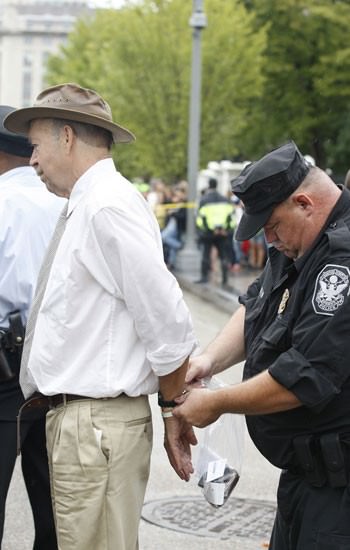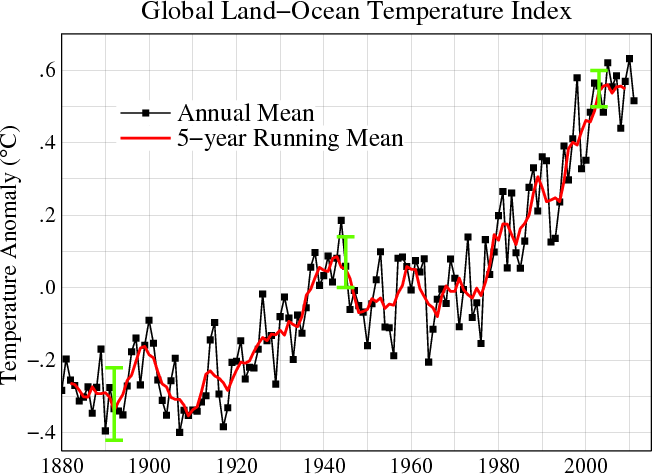[/caption]
Editor’s note: This interview is from DailyClimate.org and Climate Query is a semi-weekly feature offered by Daily Climate, presenting short Q&A’s with players large and small in the climate arena. Read other articles in the series more at Climate Query.
NASA’s chief climate scientist James E. Hansen built his career studying Earth’s atmosphere and modeling humans’ potential impacts on climate. Then he realized that laboratory work wasn’t enough. Hansen never thought his decision to study atmospheric models would lead to his arrest. But there he was in handcuffs this summer, protesting at the White House against a pipeline that would carry crude oil from Alberta’s oil sands to the Gulf of Mexico.
It wasn’t the first arrest, either. Hansen, who has directed NASA’s Goddard Institute for Space Studies for 31 years, earned the sobriquet “father of global warming” after testifying before Congress in 1988 on the dangers of global warming. He appeared again in 1989. Then he quietly returned to his work, turning aside television and media requests for the next 15 years because, as he said, “you have no time to do the science if you’re talking to the media.”
That approach changed in 2004, when he realized government climate policies worldwide failed to reflect the dangerous story his science was telling. Emerging from his lab, Hansen attacked Bush Administration officials for censuring and watering down climate findings. In 2008 he testified in British court on behalf of the “Kingsnorth Six,” a group of Greenpeace activists who successfully claimed their effort to shut down a power plant was justified under British law because it prevented the greater harm of climate change. In 2009 and 2010, Hansen was arrested protesting mountaintop-removal coal mining.

DailyClimate.org editor Douglas Fischer caught up with Hansen in December at the American Geophysical Union meeting in San Francisco, where the scientist previewed findings about impacts the world courts with its unslacked appetite for carbon-based fuels.
Question: Do you fear you have lost some of your scientific credibility by protesting at the coal plants or by becoming more of a voice in the climate debate?
Hansen: If I was not publishing papers in the peer reviewed literature, then that would be a valid criticism. But I am still publishing. I’m trying to make that science clear to the public. It’s not easy: The scientific evidence has really become very clear, and we’re not doing a very good job of communicating that.
Q: Climate policy has become less a scientific question and more a cultural marker. How can science influence those values and attitudes?
Hansen: We need to make clear to the public what’s really going on. If they just listen to politicians, they don’t understand the story because nothing is being done.
Q: Do reporters ever say, “Look, I can’t touch you as a source because you’re involved in 350.org or the coal plants or these protests”?
Hansen: The fossil fuel industry and those who prefer business as usual – they will use that. But look at my coauthors. I’ve got some of the best scientists in the world.
Q: Let’s flip the question: Do scientists ever say, “Jim, I wish I could get out there the way you are, but I’m afraid, I don’t have the support”?
Hansen: There are consequences of becoming a target. Look at the people who have been the principal targets: Phil Jones, Michael Mann, Ben Santer. Their science has been confirmed. And yet (the attacks) took a toll on them. Of course that’s going to cause other scientists not to step out.
Q: Failure to develop a climate policy isn’t a fault of just one party or one person.
Hansen: That’s right, and that’s not understood. If you say, “Democrats are the ones who favor doing something,” look at the records of the last several administrations: Emissions increased fastest during the Clinton/Gore administration. And (Democrats) proposed a policy that is not going to do anything significant. It’s designed by big banks and it favors big oil and big coal and big utilities.
Q: You’ve never liked a “cap-and-trade” approach.
Hansen: The only way you can solve the problem is with a simple, honest price on carbon. There’s no reason to bring banks into this.
Q: Where’s the clear climate message?
Hansen: Obama could’ve done it if he had started out when he had 70 percent approval and if he followed a policy like Franklin Roosevelt and had fireside chats. It’s not that difficult. It can be explained.
Q: How long can emissions increase before we risk serious impacts?
Hansen: We really should be aiming to keep CO2 no higher than about 350 parts per million and possibly somewhat less than that if we want to maintain stable ice sheets and stable shore lines and avoid many other issues. That would require starting today. We’d have to reduce CO2 emissions at six percent a year if we began next year. If we began five years ago, it would’ve been three percent. If we wait until 2020, it becomes 15 percent.
So if we’re hoping to maintain a planet that looks like the one that humanity has known, we’re out of time right now.
Interview conducted and condensed by Douglas Fischer, DailyClimate.org

